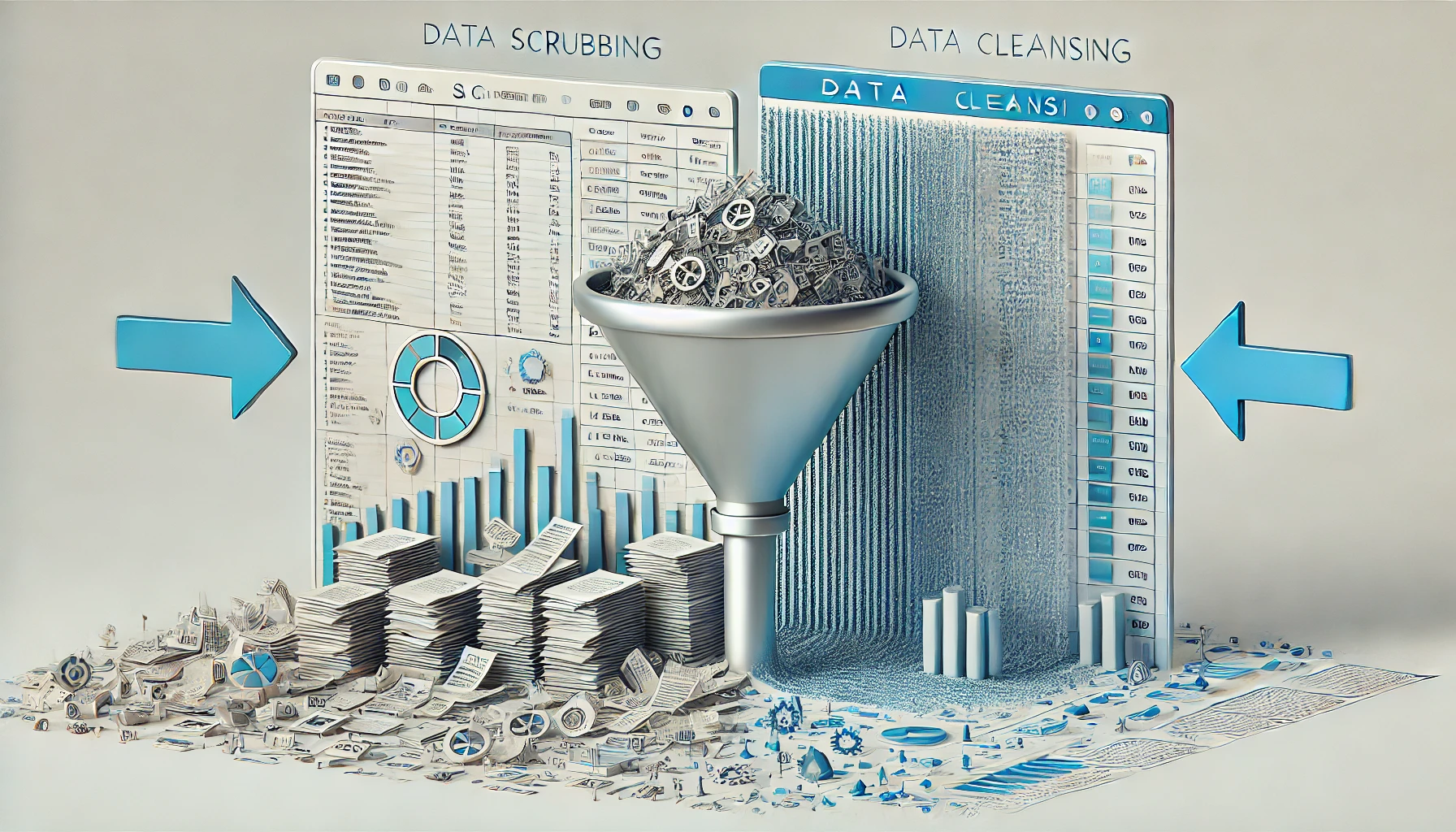Explore the nuanced world of data scrubbing vs data cleansing – two crucial components in the realm of data management. Unravel the fundamental disparities between these practices and discover how each plays a pivotal role in ensuring the accuracy and reliability of your organization’s data. By shedding light on the eight vital aspects that set data scrubbing apart from data cleansing, you’ll gain a deeper understanding of how to optimize your data processes for maximum efficiency and effectiveness.
Definitions
When distinguishing between data scrubbing and data cleansing, it is essential to first understand the precise definitions of these terms. Data quality refers to the condition of data being accurate, complete, and reliable for its intended use. Data integrity, on the other hand, focuses on maintaining the accuracy and consistency of data over its entire lifecycle.
Data scrubbing involves the process of identifying and correcting inaccuracies or inconsistencies within a dataset. It aims to improve data quality by removing duplicate records, fixing formatting errors, and standardizing data fields. Data scrubbing helps enhance the overall accuracy and reliability of the data, ensuring that it is suitable for analysis and decision-making purposes.
Data cleansing, on the other hand, is a broader term that encompasses various processes such as data scrubbing, data validation, and data enrichment. It focuses on detecting and correcting errors in a dataset to improve data quality and integrity. By cleansing data, organizations can ensure that their data is up-to-date, accurate, and consistent, thereby enabling better business insights and decisions.
Similarities
Both data scrubbing and data cleansing share key commonalities in their objective to enhance data quality and accuracy. They both involve the process of identifying and correcting errors or inconsistencies within a dataset. Additionally, both practices aim to improve the overall reliability and usability of data for decision-making purposes.
Key Commonalities
Data scrubbing and data cleansing, though distinct processes, share key commonalities that are essential for ensuring data quality and integrity in various industries. Both data scrubbing and data cleansing focus on enhancing data quality by detecting and correcting errors within datasets. Error detection is a fundamental aspect common to both practices.
By identifying inaccuracies, inconsistencies, and missing information, data scrubbing and data cleansing aim to improve the overall quality of data. This process helps in ensuring that data is accurate, reliable, and up to date. Additionally, both techniques involve the removal of duplicate entries, which is crucial for maintaining clean and organized databases.
Furthermore, data scrubbing and data cleansing play a vital role in enhancing decision-making processes by providing users with reliable and trustworthy data. By addressing errors and inconsistencies, these practices contribute to increased operational efficiency and effectiveness within organizations. Overall, the key commonalities between data scrubbing and data cleansing underscore their shared objective of optimizing data quality and integrity.
Shared Characteristics
Frequently overlooked, the nuances between data scrubbing and data cleansing often lead to misconceptions regarding their similarities. Both data scrubbing and data cleansing are crucial processes in ensuring data quality within an organization. They share the common goal of improving data quality by detecting and correcting errors present in datasets.
Data quality is a fundamental aspect shared by data scrubbing and data cleansing. Both processes aim to enhance the accuracy, consistency, and completeness of data. By identifying and rectifying errors, duplicates, inconsistencies, and irrelevant data, data quality is significantly improved.
Error detection is another key similarity between data scrubbing and data cleansing. Both methods involve the systematic examination of data to detect inaccuracies, inconsistencies, and anomalies. By identifying errors in datasets, organizations can ensure that their data is reliable and trustworthy for making informed decisions.
In essence, the shared characteristics of data scrubbing and data cleansing revolve around their commitment to enhancing data quality through meticulous error detection and correction processes.
Differences
When comparing data scrubbing and data cleansing, it is crucial to understand the distinctions between the two processes. Data scrubbing primarily focuses on identifying and correcting inaccuracies in a dataset, while data cleansing involves a broader approach that encompasses removing duplicates, standardizing formats, and enhancing overall data quality. These process variances directly impact the accuracy and reliability of the data, highlighting the importance of selecting the appropriate method based on the specific needs of the data analysis.
Scrubbing Vs Cleansing
When distinguishing between data scrubbing and data cleansing, it’s essential to understand the nuanced differences in their processes and objectives. Data scrubbing primarily focuses on enhancing data quality by identifying and correcting inaccuracies, inconsistencies, and duplicates within a dataset. This process is crucial for improving data integrity, ensuring that the information is accurate, reliable, and up-to-date. On the other hand, data cleansing goes beyond just correcting errors. It involves a more comprehensive approach to improving data quality by removing irrelevant or outdated information, standardizing formats, and enriching data with missing elements.
While both data scrubbing and data cleansing aim to enhance data quality and integrity, the key difference lies in their scope and depth. Data scrubbing targets specific issues within a dataset to rectify inaccuracies, whereas data cleansing involves a broader range of actions to ensure that the data is clean, consistent, and usable for analysis and decision-making purposes.
Process Variances
To delve into the nuances of process variances between data scrubbing and data cleansing, it is imperative to dissect their fundamental methodologies and objectives. The key process differences between data scrubbing and data cleansing lie in their focus and approach towards enhancing data quality. Data scrubbing primarily involves identifying and rectifying inaccuracies, inconsistencies, and errors in datasets. This process focuses on cleaning up messy data by removing duplicates, correcting typos, and standardizing formats.
On the other hand, data cleansing goes beyond just cleaning data by also enriching it. This process involves validating data accuracy, completeness, and relevance. Data cleansing aims to ensure that the data is up-to-date, relevant, and reliable for analysis and decision-making purposes. While both data scrubbing and data cleansing have the common goal of improving data quality, their process variances determine the thoroughness and extent to which data is refined and enhanced. Understanding these process differences is crucial for organizations to effectively manage and utilize their data assets.
Impact on Accuracy
Considering the impact on accuracy, the disparities between data scrubbing and data cleansing become evident.
- Data Quality: Data scrubbing focuses on identifying and correcting inaccurate or irrelevant data, which directly impacts data quality. On the other hand, data cleansing goes a step further by not only correcting errors but also enriching and standardizing data to enhance its overall quality.
- Error Reduction: Both data scrubbing and data cleansing aim to reduce errors within datasets. Data scrubbing primarily targets inconsistencies and duplicates, whereas data cleansing involves a more comprehensive approach by detecting outliers, missing values, and inconsistencies to ensure high accuracy.
- Precision: Data cleansing is known for its precision in handling data inaccuracies, ensuring that the information is correct, complete, and consistent. Data scrubbing, while effective in removing errors, may not always refine data to the same level of precision.
- Impact on Decision Making: The level of accuracy achieved through data cleansing directly influences the reliability of decisions made based on the data. Data scrubbing, although beneficial, may not always provide the same level of confidence due to potential data inconsistencies.
Use Cases
Data scrubbing and data cleansing are essential processes in maintaining the integrity and quality of your data. Real-world examples of data scrubbing include removing duplicate entries from a customer database, ensuring accurate mailing lists, and standardizing formats for phone numbers and addresses. On the other hand, data cleansing in industry-specific scenarios such as healthcare involves identifying and correcting inaccuracies in patient records to improve treatment outcomes and billing accuracy. In business, the implications of data cleansing are vast, ranging from enhancing customer relationship management systems to reducing errors in financial reporting.
Practical applications of data scrubbing can be seen in e-commerce platforms where cleaning up product descriptions and categories improves search functionality and user experience. In contrast, industry-specific scenarios like the financial sector rely on data cleansing to detect and rectify anomalies in transaction records for regulatory compliance. These use cases highlight how data scrubbing and data cleansing play a crucial role in ensuring accurate, reliable, and actionable data across various industries.
Effectiveness
In assessing the effectiveness of data scrubbing and data cleansing processes, the impact on data quality and organizational efficiency becomes apparent. When comparing the effectiveness of these practices, it is crucial to consider various factors that can influence the outcomes. Here are some key points to keep in mind:
- Data Accuracy: Data scrubbing focuses on correcting inaccuracies, while data cleansing goes beyond to eliminate inconsistencies and duplications, enhancing overall accuracy.
- Process Automation: Implementing automated tools in data cleansing streamlines the process, leading to quicker and more efficient results compared to manual data scrubbing.
- Integration Capabilities: Data cleansing often offers better integration with existing systems, allowing for seamless data flow and improved operational efficiency.
- Sustainability: Establishing best practices for ongoing data maintenance ensures that the effectiveness of both data scrubbing and data cleansing processes is maintained over time.
Implementation
Moving from the assessment of effectiveness to the practical realm of implementation, the process of integrating data scrubbing and data cleansing within your organization requires careful planning and execution. When considering practical applications, it is essential to identify real-world scenarios where data scrubbing and data cleansing can add value. Best practices and industry standards play a crucial role in guiding the implementation process.
To effectively implement data scrubbing and data cleansing, start by establishing clear objectives and goals. Conduct a thorough assessment of your current data quality issues to determine the scope of work required. Next, develop a detailed plan outlining the specific steps, resources, and timeline for implementation.
Ensure that you have the necessary tools and technologies in place to support the data scrubbing and data cleansing processes. Additionally, train your team on the best practices and industry standards to ensure compliance and efficiency. Regularly monitor and evaluate the implementation progress to make adjustments as needed. By following these guidelines, you can successfully integrate data scrubbing and data cleansing into your organization’s data management practices.
Benefits
When considering the benefits of incorporating data scrubbing and data cleansing into your organization’s data management processes, it becomes evident that these practices play a crucial role in enhancing data quality and reliability.
- Improved Data Quality: By removing duplicates, inconsistencies, and errors, data scrubbing and cleansing enhance the overall quality of your database.
- Enhanced Data Integrity: These processes ensure that your data is accurate, consistent, and up-to-date, improving the reliability of your information.
- Increased Efficiency: With clean and accurate data, your organization can make better-informed decisions faster, leading to improved operational efficiency.
- Compliance and Security: Data scrubbing and cleansing help in maintaining compliance with regulations and protecting sensitive information, reducing risks associated with data breaches.
Incorporating data scrubbing and data cleansing into your data management strategy can yield substantial benefits by ensuring that your data is of high quality, reliable, and secure, ultimately leading to better decision-making and operational efficiency.
Conclusion
By taking a comprehensive approach to data management that includes data scrubbing and data cleansing, organizations can significantly enhance the quality, integrity, and security of their data assets. Data quality is crucial for making informed business decisions and maintaining compliance with regulations. Implementing best practices in data scrubbing and data cleansing ensures that inaccurate, incomplete, or irrelevant data is identified and rectified, leading to more reliable and trustworthy data.
Frequently Asked Questions
How Does Data Scrubbing/Cleansing Impact Data Privacy Regulations?
When considering data privacy regulations, compliance considerations and legal implications are crucial. Data scrubbing/cleansing plays a vital role in ensuring compliance by removing redundant or inaccurate data, thus enhancing data privacy protection.
Can Data Scrubbing/Cleansing Be Automated for Real-Time Data Processing?
You can harness the power of machine learning algorithms to automate data scrubbing and cleansing, enabling real-time integration. Imagine your data purified effortlessly as you go. It’s like having a diligent helper at your side.
What Are the Common Challenges Faced During Data Scrubbing/Cleansing?
When data scrubbing/cleansing, you may encounter challenges like inconsistent formats, missing values, and duplicate entries, affecting data quality and accuracy. Resolving these issues through automated tools improves overall data integrity and reliability for effective decision-making.
Is There a Recommended Frequency for Conducting Data Scrubbing/Cleansing?
To maintain optimal data quality, it’s recommended to conduct regular data scrubbing/cleansing. Best practices suggest performing these processes quarterly or semi-annually. Consistent maintenance ensures accurate, reliable data for informed decision-making and operational efficiency.
How Do Data Scrubbing/Cleansing Tools Handle Unstructured Data Formats?
When it comes to handling unstructured data formats, data scrubbing/cleansing tools utilize advanced techniques like text analysis and image recognition. These methods help in converting messy data into structured, usable information, ensuring accuracy and efficiency.




